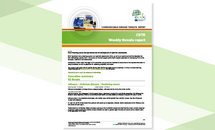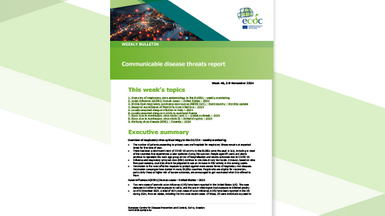Communicable disease threats report, 14-20 August 2016, week 33
The ECDC Communicable Disease Threats Report (CDTR) is a weekly bulletin for epidemiologists and health professionals on active public health threats. This issue covers the period 14-20 August 2016 and includes updates on poliomyelitis, Zika virus, yellow fever, West Nile fever, malaria in Greece, avian influenzas and the Summer Olympic Games in Brazil.
Executive Summary
This issue covers the period 14 to 20 August 2016 and includes updates on West Nile virus, malaria in Greece, Zika virus infection and influenza A(H7N9).
West Nile virus: As of 18 August 2016, 22 cases of West Nile fever in humans have been reported in the EU Member States and 45 cases in the neighbouring countries, since the beginning of the 2016 transmission season. During the past week, 11 new cases of West Nile fever have been reported in Spain (1), Romania (5) and Hungary (5).
ECDC produces weekly West Nile fever (WNF) maps during the transmission season (i.e. June to November) to inform blood safety authorities of WNF-affected areas.
Malaria in Greece: On 12 August 2016, two cases of malaria were diagnosed in the Aghios Vasileios community in Thessaloniki. Response measures are ongoing. Two previous possible locally acquired cases have been reported in the region of West Greece in 2016.
The risk for travellers is considered to be low. The use of standard mosquito biting prevention measures continues to be recommended. More so, ECDC’s conclusions from its previous Rapid Risk Assessment on malaria, October 2011, are still valid.
Zika virus infection: Since week 45/2015, 19 countries (Austria, Belgium, the Czech Republic, Denmark, Finland, France, Ireland, Italy, Luxembourg, Malta, the Netherlands, Norway, Portugal, Romania, Slovakia, Slovenia, Spain, Sweden and the UK) have reported 1 265 travel-associated Zika virus infections through The European Surveillance System (TESSy). France reported 56% of the cases. Over the same time period, six countries reported 69 Zika cases among pregnant women.
ECDC publishes an epidemiological update every Friday together with maps containing information on countries or territories which have reported confirmed autochthonous cases of Zika virus infection. A Zika virus infection Atlas is also available on the ECDC website. ECDC updated its Rapid Risk Assessment on Zika on 12 July 2016.
Influenza A(H7N9) - China: On 18 August, WHO reported five new influenza A(H7N9) cases in Fujian and Hebei provinces in China. The cases reported are from the same family and human-to human transmission cannot be ruled out. However, to date, no further transmission has been reported.
This outbreak is caused by a novel reassortant avian influenza virus capable of causing severe disease in humans. This is a zoonotic outbreak, in which the virus is transmitted sporadically to humans in close contact with the animal reservoir, similar to the influenza A(H5N1) situation.
Imported cases of influenza A(H7N9) may be detected in Europe.
However, the risk of the disease spreading among humans following an importation to Europe is considered to be very low. People in the EU presenting with severe respiratory infection and a history of potential exposure in the outbreak area will require careful investigation.
ECDC published an updated Rapid Risk Assessment on influenza A(H7N9), 3 February 2015. And a guidance document Supporting diagnostic preparedness for detection of avian influenza A(H7N9) viruses in Europe for laboratories was published on 24 April 2013.
Download






